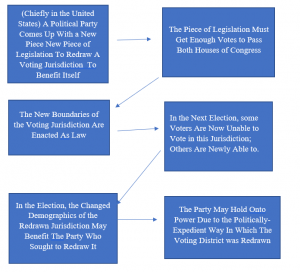Liam Plosker 61201224
Assignment 1:3: Three Definitions
Introduction: The objective of Assignment 1:3 is to understand the role definitions play in technical writing. To fulfil this objective, the parenthetical, sentence and expanded definitions of a relatively complex term will be examined. Additionally, this term’s audience and situation will be established to better understand its meaning. By viewing the chosen term from these multiple vantage points, it will provide greater context, and insight into its definition.
Term: Gerrymandering
Situation/Audience: Members of the United States’ Congress in Washington, D.C. have been elected to congress by a narrow margin in their recent election. Seeking to safeguard their power against potential opponents, they attempt to pass legislation which redraws the boundaries of their jurisdiction in a more favorable manner, to include populations that are more likely to vote for them in the forthcoming election.
Parenthetical Definition: Gerrymandering, in U.S. politics, is the practice of drawing the boundaries of electoral districts in a way that gives one political party an unfair advantage over its rivals (political or partisan gerrymandering) or that dilutes the voting power of members of ethnic or linguistic minority groups (racial gerrymandering). (Duignan, Brian, The Editor’s Encyclopaedia of Britannica, 2012)
Sentence Definition: Gerrymandering is the manipulation of an electoral constituency’s boundaries for political gain, often carried out with a bias against marginalized groups.
Expanded Definitions:
Required Conditions:
For gerrymandering attempts to be successful, a political party must already have enough seats in the two houses of U.S. Congress able to pass legislation that can redraw an electoral constituency according to their party’s political whims. Without enough seats to cast majority votes on these politically-motivated changes, such legislation would be blocked in the house and never come to fruition.
Examples:
Gerrymandering is primarily used to describe a politically-expedient practice that takes place in the United States, as the U.S. Political System is uniquely situated for gerrymandering to occur, due to its use of an electoral collage rather than the popular vote to determine who the powerbrokers of its government, such as the representatives of Congress, are. For instance, redrawing voting jurisdictions in a political system that relied solely on the popular vote would not influence results and potentially change who is elected to power.
Analysis of Parts:
- In the United States, a piece of legislation that seeks to redraw the lines of an electoral constituency must have enough votes to pass the houses of Congress.
- If the piece of legislation passes both houses of Congress, it officially becomes enacted as law, and the boundaries of the voting district have now changed.
- In the next election, voters who were once a part of the old jurisdiction may now be unable to vote in it, and must have to vote in a neighbouring jurisdiction instead. On the other hand, voters who may have previously voted in a neighbouring jurisdiction may now be able to vote in this jurisdiction instead.
- The shaken-up demographics of the newly-drawn jurisdiction may effect the outcome of the next election, potentially benefiting the party which drew up the legislation and allowing them to gain or maintain political control of that jurisdiction.
Visuals:

References:
Duignan, Brian. The Editor’s Encyclopaedia of Britannica, 2012. Retrieved February 8, 2023. https://www.britannica.com/topic/gerrymandering
The Merriam Webster Dictionary, 2019. Retrieved February 8, 2023. https://www.merriam-webster.com/dictionary/gerrymandering
The Cambridge Dictionary, 2017. Retrieved February 8, 2023. https://dictionary.cambridge.org/dictionary/english/gerrymandering
Leave a Reply